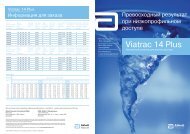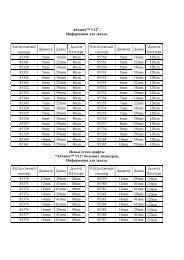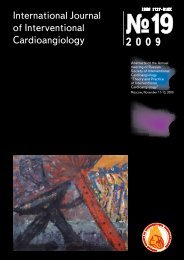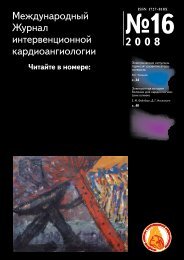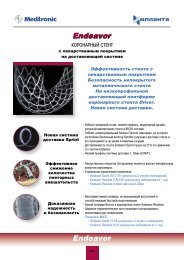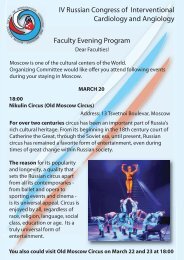Results of Coronary Stenting using the Stents with
Results of Coronary Stenting using the Stents with
Results of Coronary Stenting using the Stents with
Create successful ePaper yourself
Turn your PDF publications into a flip-book with our unique Google optimized e-Paper software.
Interventional cardiology<br />
a homogenously dosed concentration and during a<br />
pre-determined period <strong>of</strong> time corresponding to <strong>the</strong><br />
phases <strong>of</strong> vessel’s healing (41). The system <strong>of</strong> drug<br />
delivery preserves its properties after sterilization,<br />
is able to change its geometrical form and volume<br />
following stent implantation and deployment and<br />
is resistant to mechanical influence caused by balloon<br />
inflation (52). The first prospective double blind<br />
multi-center trial (RAVEL) compared <strong>the</strong> results <strong>of</strong><br />
angioplasty <strong>with</strong> Sirolimus-eluting stents and <strong>with</strong><br />
bare metal stents (Bx Velocity) in 238 randomized<br />
patients <strong>with</strong> primary coronary lesions. At six months<br />
<strong>the</strong> rate <strong>of</strong> restenoses in <strong>the</strong> Sirolimus group was 0%<br />
vs. 26,6% in <strong>the</strong> control group. According to angiography<br />
data, late decrease <strong>of</strong> arterial lumen (so-called<br />
late lumen loss), as well as <strong>the</strong> number <strong>of</strong> MACE in <strong>the</strong><br />
Sirolimus group were significantly lower (54). SIRIUS<br />
trial was <strong>the</strong> largest-scale study <strong>of</strong> Sirolimus-eluting<br />
stents. It was conducted in 53 centers throughout <strong>the</strong><br />
USA and comprised 1101 randomly selected patients<br />
<strong>with</strong> primary coronary lesions. The patients received<br />
Sirolimus-eluting stents and bare metal stents. Final<br />
results <strong>of</strong> <strong>the</strong> trial have demonstrated a significant<br />
decrease <strong>of</strong> <strong>the</strong> rate <strong>of</strong> restenoses, late lumen loss<br />
and necessity <strong>of</strong> repeated revascularization in <strong>the</strong><br />
Sirolimus group (55). Primary results <strong>of</strong> <strong>the</strong> use <strong>of</strong><br />
Sirolimus-eluting stents for <strong>the</strong> treatment <strong>of</strong> in-stent<br />
stenosis are equally encouraging. A non-randomized<br />
study has shown <strong>the</strong> rate <strong>of</strong> restenosis below 10%.<br />
In comparison <strong>with</strong> <strong>the</strong> standard coronary stent, a<br />
Sirolimus-eluting stent <strong>of</strong>fers better perspectives<br />
for <strong>the</strong> prevention <strong>of</strong> proliferation <strong>of</strong> <strong>the</strong> neointima,<br />
<strong>of</strong> restenosis and restenosis-related unfavorable<br />
clinical events (26). At present <strong>the</strong>re are many various<br />
drug-eluting stents. Antiproliferative agents used in<br />
most available stents are Rapamycin and Paclitaxel.<br />
All stents <strong>with</strong>out distinction are balloon-deployable,<br />
processed <strong>with</strong> polymer coating containing a cytostatic<br />
agent. The analogues <strong>of</strong> Rapamycin available<br />
at <strong>the</strong> present time include: Everolimus (stent Xience<br />
V, Abbot), Zotarolimus (stent Endeavor, Medtronic),<br />
Sirolimus (stent Cypher select, Cordis), Biolimus-A9<br />
(stent Biomatrix, Biosensors). These agents are used<br />
in <strong>the</strong> coatings <strong>of</strong> second-generation stents. Comparative<br />
characteristics <strong>of</strong> <strong>the</strong> most widely used DES<br />
are presented in Table 1.<br />
While <strong>the</strong> use <strong>of</strong> stents for PCI can be compared to<br />
a breakthrough resulting in a significant decrease <strong>of</strong><br />
<strong>the</strong> rate <strong>of</strong> restenosis (20), <strong>the</strong> advent <strong>of</strong> stents <strong>with</strong><br />
drug-eluting coating became a true revolution in <strong>the</strong><br />
treatment <strong>of</strong> <strong>the</strong> coronary artery disease (56).<br />
The stent Xience V (Abbott Vascular, USA), is one<br />
<strong>of</strong> <strong>the</strong> best second-generation stents. The safety and<br />
<strong>the</strong> effectiveness <strong>of</strong> Xience V have been statistically<br />
confirmed in numerous clinical trials comparing this<br />
stent <strong>with</strong> bare metal stents as well as <strong>with</strong> o<strong>the</strong>r<br />
second-generation stents.<br />
Here is a brief summary <strong>of</strong> <strong>the</strong>se trials<br />
1. SPIRIT I. A 6-months (5 years) follow-up <strong>of</strong> 60<br />
patients in comparison <strong>with</strong> a bare metal stent (Multi<br />
Link Vision) revealed that <strong>the</strong> rate <strong>of</strong> MACE, including<br />
death, myocardial infarction, emergency and elective<br />
CABG was 7,14% for Xience V, and 18,75% for Multi<br />
Link Vision (57, 58, 59).<br />
2. SPIRIT II. The data <strong>of</strong> a clinical trial conducted<br />
in a group <strong>of</strong> 300 patients and comparing <strong>the</strong> Xience<br />
V stent <strong>with</strong> Paclitaxel-eluting stent Taxus Express2 /<br />
Taxus Liberte, have been presented by P. Serruys at<br />
58th Annual session <strong>of</strong> <strong>the</strong> American College <strong>of</strong> Cardiology<br />
(АСС-2009). The rate <strong>of</strong> MACE at 6 months<br />
was 2,7% for Xience V vs. 6,5% for Taxus; at 2 years–<br />
6,6% and 11,0%, respectively. (60).<br />
3. SPIRIT III. (<strong>the</strong> results have been presented at<br />
PCR-2008 in Barcelona, Spain, on May 13, 2008): In<br />
a group <strong>of</strong> 1002 patients <strong>the</strong> rate <strong>of</strong> MACE decreased<br />
at 2 years by 45% in comparison <strong>with</strong> Taxus stent<br />
(6,0% for Xience V vs. 10,3% for Taxus) (61, 62, 63).<br />
4. Meta-analysis <strong>of</strong> <strong>the</strong> data <strong>of</strong> SPIRIT II + SPIRIT<br />
III trials has shown <strong>the</strong> following key results for Xience<br />
V stent at 2 years follow-up: clinically significant<br />
decrease <strong>of</strong> <strong>the</strong> risk <strong>of</strong> ischemia, caused by target<br />
vessel failure by 31% in comparison <strong>with</strong> Taxus stent<br />
(10,4 % for Xience V vs.14,7% for Taxus). The risk <strong>of</strong><br />
death from all causes decreased by 28% in comparison<br />
<strong>with</strong> Taxus stent (2,4% for Xience V vs.3,3% for<br />
Taxus). The risk <strong>of</strong> cardiac death decreased by 28%<br />
in comparison <strong>with</strong> Taxus stent (0,9% for Xience V<br />
vs. 1,3% for Taxus). Besides, <strong>the</strong> authors have noted<br />
clinically significant decrease <strong>of</strong> <strong>the</strong> risk <strong>of</strong> myocardial<br />
infarction (MI) by 45% in comparison <strong>with</strong> Taxus<br />
(3,1% for Xience V vs. 5,6% for Taxus); clinically significant<br />
decrease <strong>of</strong> <strong>the</strong> risk <strong>of</strong> ischemia caused by<br />
target lesion revascularization (TLR) by 1% in comparison<br />
<strong>with</strong> TAXUS (4,1% for Xience V vs. 6,8% for<br />
Taxus). Also a low rate <strong>of</strong> stent thrombosis between<br />
<strong>the</strong> years 1 and 2 was noted (0,5% for Xience V and<br />
0,8% for Taxus) (64).<br />
5. SPIRIT IV. In September 2009, at ТСТ held<br />
in San-Francisco, G. W. Stone has presented <strong>the</strong><br />
results <strong>of</strong> SPIRIT IV trial comprising 3690 patients,<br />
including 1185 patients <strong>with</strong> diabetes mellitus<br />
(32.2%). According to this study, <strong>the</strong> rate <strong>of</strong> MACE<br />
decreased by 39% in comparison <strong>with</strong> Taxus stent<br />
(4,2% for Xience V vs. 6,9% for Taxus). At 1 year<br />
<strong>the</strong>re was a significant reduction <strong>of</strong> <strong>the</strong> target lesion<br />
failure in comparison <strong>with</strong> Taxus Express (Xience<br />
V 4.2% vs. Taxus 6.8%). Besides, <strong>with</strong> <strong>the</strong> use <strong>of</strong><br />
Taxus <strong>the</strong> rate <strong>of</strong> ischemia-driven target lesion revasculariztion<br />
(ID-TLR), was higher than <strong>with</strong> <strong>the</strong><br />
use <strong>of</strong> Xience V, <strong>with</strong> relative risk decrease by 46%<br />
(2,5% for Xience V vs. 4,6% for Taxus). Also <strong>the</strong><br />
number <strong>of</strong> cases <strong>of</strong> cardiac death or target-vessel<br />
revascularization decreased by 31% in comparison<br />
<strong>with</strong> Taxus stent TAXUS (2,2% for XIENCE V vs.3,2%<br />
for TAXUS). The number <strong>of</strong> myocardial infarctions<br />
related to <strong>the</strong> target vessel decreased by 38% in<br />
comparison <strong>with</strong> Taxus (1,8% for Xience V vs. 2,9%<br />
for Taxus). The number <strong>of</strong> stent thromboses decreased<br />
by 80% in comparison <strong>with</strong> Taxus stent<br />
(0,17% for Xience V vs. 0,85% for Taxus); <strong>with</strong> <strong>the</strong><br />
28<br />
(№ 26, 2011)




